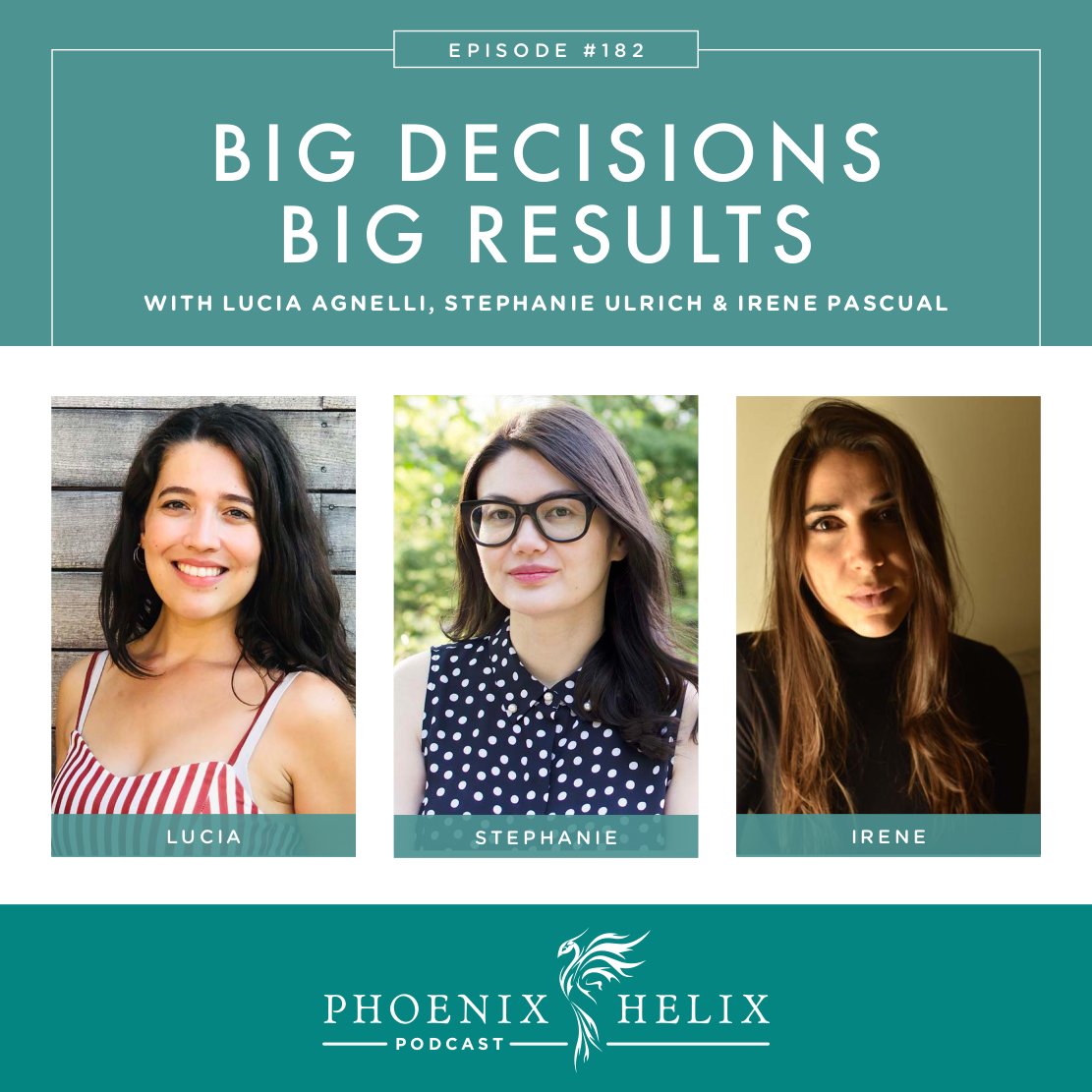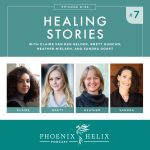When a Big Change Makes a Big Difference
When it comes to a healing lifestyle, our daily choices matter. Small steps and habits add up over time, and many of my podcasts teach those skills. Today, we’re going in a different direction. There are times when the big picture is overwhelming everything else. It might be a toxic job, a toxic relationship, or a toxic home. Change is rarely easy, even in difficult situations. Sometimes you need to wait for the right time and opportunity. Sometimes it’s a matter of courage. Other times it’s a matter of resources. Usually, it’s a combination of these things. Today, I’m sharing three inspiring stories of people who made big changes for their health. Lucia moved to a new country. Stephanie left a toxic job. And Irene left an abusive relationship.
Listen to the Show
- Subscribe to my podcast through your favorite podcast app: iTunes, Stitcher, Google, TuneIn, Spotify, Amazon, etc.
- You can also listen to the episode right here through the player below, and if you subscribe to my newsletter you’ll get notified of future episodes.
Podcast: Play in new window | Download
Show Notes
- Intro (0:00)
- Thank You To Our Podcast Sponsor – Functional Nutrition Alliance (2:04)
- Full Body Systems is their internationally acclaimed, 10-month online functional nutrition immersion training program.
- It’s designed by world-renowned educator, Andrea Nakayama. Many of you know her as one of my most popular podcast guests. Her unique way of working with patients often leads to results where other practitioners hit dead ends. This program teaches you to do the same.
- If you’re already trained as a health coach, nutritionist, or medical practitioner and want to more effectively help your clients break through healing plateaus, this class is for you!
- And if you’re an aspiring practitioner just getting started, this might be the only training you need.
- You’ll gain detailed knowledge of all the systems in the body, how they interact, how problems develop, and how to personalize diet and lifestyle recommendations for each unique client.
- Enrollment is currently open. To learn more, visit FxNutrition.com/Eileen.
- Lucia – Moving to a New Country (3:37)
- Lucia Agnelli has Crohn’s disease. She was diagnosed in the hospital in 2016. She went in for emergency surgery for what she thought was appendicitis and woke up with a Crohn’s diagnosis instead. It was shocking. She was put on medication, offered no lifestyle advice, and sent on her way. 3 years later, she had a second surgery where 20 cm of her intestine was removed. In spite of the medication, she had an uncontrolled flare that required drastic intervention.
- Both surgeries inspired big changes. The first one inspired a move from South Africa to Sweden. Lucia realized life was short and she wanted to create a life she loved. She and her husband have EU passports, which made the move easy – there was no paperwork needed. However, they did need to get jobs when they arrived in order to access the country’s benefits (free healthcare and paid leave when needed). Sweden was known for balance and a slower pace, and that was what she was seeking. However, such a big move was stressful and actually hard on her body. She doesn’t regret it – it was a mindset shift that forever changed how she viewed her life. But big changes don’t always fix everything. For Lucia, it was the second surgery that inspired the diet and lifestyle changes that helped her manage her disease (AIP, gut healing, boundaries, stress management, and trusting her own intuition on what she needs to thrive). She remembers doing a superhero pose in the hospital before going into this second surgery, and it felt like a turning point where she knew she was empowered to make the changes she needed to going forward.
- Now, life is good. She’s learned how to live well with autoimmune disease.
- Lucia is now a holistic health coach and works with people 1:1. You can connect with her through her website: Alight with Healing.
- Stephanie – Leaving a Toxic Job (23:51)
- Stephanie Ulrich has Hashimoto’s disease, Undifferentiated Connective Tissue Disease (UCTD), and Eosinophilic esophagitis (EoE). She had a health crisis before each diagnosis, but was lucky enough to get diagnosed relatively quickly each time. She was diagnosed with Hashimoto’s in 2013, and going gluten-free was enough to manage her symptoms for the next 5 years. In 2018, she experienced sudden onset of EoE which was terrifying, because in addition to severe chest and abdominal pain that made it difficult to walk, the swelling in her esophagus made it difficult to swallow anything, even water. This has been the most difficult to treat. UCTD is her most recent diagnosis, explaining years of skin rashes and bodywide inflammation. Since diagnosis doesn’t always lead to effective treatment, Stephanie became her own health advocate. She sought out specialists. For EoE, she sees Dr. Mirna Chehade at Mt. Sinai. For UCTD, she sees Dr. Weijia Yuan at Weill Cornell.
- Throughout the time of her escalating health problems, Stephanie worked as an architect. It’s a highly competitive, high-stress career where people are expected to work long hours. Stephanie often worked 7 days a week, ate meals at her desk, and sometimes worked until midnight. Work consumed her life. Leading up to her Hashimoto’s diagnosis, she struggled to discern whether her exhaustion was simply overwork or an underlying health issue. Hashimoto’s was her first health wake-up call, and she changed her diet but didn’t change her work-life balance. Stress management wasn’t yet on her radar. Leading up to her EoE diagnosis, work had become even more intense. In addition to the long hours, she was now required to travel and spend time on construction sites. EoE led to multiple medical appointments and the need to prepare all her own food – all of which took time. And while she was able to hide her Hashimoto’s symptoms from her coworkers, she couldn’t hide EoE. Her weight loss and specialized diet were obvious, which brought the stress of coworkers commenting on both. It was eventually easier to become honest with herself and her workplace about what she could and couldn’t handle. She set boundaries, giving up travel and carving out time for medical appointments and self-care. However, even after these conversations, there was a constant tension between workplace expectations and her health needs.
- Stephanie eventually chose to leave her job and focus on her health. It was one of the hardest decisions she ever made, because her work was her identity. Who would she be without it? But at the same time, it felt like the decision was made for her. She was too sick to keep up with the demanding work schedule. Her therapist helped greatly during this time. She was able to reframe it as choosing herself over her job for the first time in her life. In addition to regaining her health, it was an opportunity for personal growth. She supported herself with freelance work and loved the flexibility that provided. Her goal is to transition to a career in nutrition.
- Leaving her job made a huge difference in her health. She doesn’t believe she could have healed otherwise. It immediately felt like a weight had been lifted. She was able to focus on her relationship with food – overcoming food fear and tuning into her body’s signals. She expanded her list of foods from 5 to almost 30 and continues to expand. She even discovered a new love of cooking and baking and started a blog. Her EoE is now well-managed, and her health is better in every way – mentally and physically.
- Research has confirmed the connection between stress and autoimmune disease. It increases the risk of developing autoimmune disease, and increases the intensity of flares as well. Stephanie mentioned how helpful a therapist was during this time. In addition to supporting us mentally and emotionally, research shows that psychotherapy reduces inflammation and improves immune function.
- Stephanie shares AIP-friendly recipes through her website, The Open Cookbook.
- Thank You To Our Podcast Sponsor – Luminance Skincare (47:15)
- This week, I’m highlighting their new tinted lip balms. Conventional lipsticks contain 40+ ingredients including toxic colorants and chemicals, and what we put on our lips, we naturally ingest. So, Luminance set out to create something cleaner. They tint their lip balms with laboratory grade oxides that are 99.4% pure and absolutely safe for your skin. They contain no bees wax or paraffin, which can dry out your lips. Instead, they use natural ingredients that provide moisture and color at the same time.
- Whereas conventional skincare products are full of chemicals that can hurt our bodies, Luminance is made from ingredients that nourish. Their products are natural, organic, wildcrafted, non-GMO, and gluten-free (and they’re even made in a dedicated gluten-free facility). They’re also handmade in small batches within the United States.
- They have a complete face and body care line, including cleansers, toners, moisturizers, masks, acne serum, sunscreen, haircare, and more.
- Place an order here, and use the code HELIX for 10% off your first order.
- Irene – Leaving an Abusive Relationship (48:57)
- Before beginning this romantic relationship, Irene Pascual had been diagnosed with Hashimoto’s disease, but it was well managed. She was in good health and had never experienced any skin symptoms. During the course of the relationship, she developed two other autoimmune diseases: psoriasis and psoriatic arthritis.
- The abuse didn’t start off severe. It escalated over time. Most of it was psychological abuse – daily insults, extreme jealousy, false accusations, controlling who she saw and what she wore. She felt like he canceled her personality completely, and she distanced herself from her friends. Physically, he would sometimes push her and throw things at her.
- The first psoriasis patch appeared one month into her relationship, and it spread as the abuse escalated. 1-1/2 years later, it had spread to both eyelids (upper and lower), both ears, and her entire scalp. It was very painful. She went to a doctor and received the psoriasis diagnosis and an immunosuppressant prescription. Unfortunately, the medication didn’t reduce her symptoms. Instead it led to her worst flare yet which involved her joints as well and she received the second diagnosis of psoriatic arthritis. It was her rock bottom – mentally, physically, and emotionally.
- Irene started working with a psychotherapist (against her partner’s wishes). Through that work, she came to realize a lack of self-love was behind her acceptance of his behavior. She wasn’t ready to leave the relationship right away. It took time and a lot of growth through therapy. She started by setting boundaries within the relationship and saying no. However, her health didn’t improve until she left the relationship altogether. It took two tries – they got back together after the first breakup and her health worsened further. Her skin became infected, and her joints hurt so much it was hard to walk. But eventually she was ready to leave for good. She remembers feeling very calm when she made that decision, and her body calmed in response. Two months after leaving, her psoriasis had reduced by 90% and eventually disappeared altogether. In the prior three years when she was in that relationship, no intervention helped the psoriasis (neither diet nor medical treatment). The psoriasis had appeared as an expression of the toxicity of that relationship, and it disappeared when she left and reclaimed her freedom to be fully herself.
- Now, she still has autoimmunity, but she’s able to manage it well. She sometimes has joint pain, but it’s mild. She no longer has trouble walking, and she’s back to working out. She continues to go to therapy, and she has a meditation practice. She’s also picked up hobbies she had left behind, and focuses on doing nice things for herself – something we often forget to do. She’s now grateful to her body for sending such strong signals that she couldn’t ignore them. She had to go through that experience to become the person she is today, and she loves herself more than she ever has. Her body still sends signals now when life gets stressful, but she listens right away.
- You can connect with Irene through Instagram.
- To My Listeners (1:06:15)
- As I end this podcast, I want to say that I know there’s privilege in this conversation. While change is never easy, it’s easier for some people to make changes than others. I think of it like brass ring opportunities – moments when we are ready and capable, and have the resources we need. Sometimes that’s an emotional readiness. Other times it’s a health readiness. And other times it’s a financial readiness. If you’re in a situation where you want to make a big change but aren’t ready yet, knowing the change you want to make is the first step. Can you instead think of a small change in that direction, to become more ready, or prepare for the right moment in the future?
- With each of the stories shared today, there was also challenge in the change. Even when it’s a good choice for us long-term, there can be some turbulence in that transition. Don’t judge yourself if that’s also true for you.
- Outro (1:08:32)
- Eileen (your podcast host) is the author of multiple books, written to help people thrive with autoimmune disease. Learn more on the Books Page.
- If you like this podcast, follow or subscribe through your favorite podcast app. You can also subscribe to Eileen’s biweekly newsletter.
- Check out the entire archive of podcast episodes.
You May Also Be Interested In
Spreading the Word
If you like the podcast, please leave a positive review in iTunes. It would mean the world to me, and also helps others find the podcast. Here are some quick instructions using your iPhone:
- If you are already subscribed to my podcast: (1) Click the purple podcast icon. (2) At the bottom of the screen, click Library. (3) At the top of the screen, click Shows. (4) Click the Phoenix Helix podcast image. (5) Scroll down the page, and you’ll see Ratings and Reviews. Scroll down a little bit more and click on Write a Review. This will bring up the review screen. Tap 5 stars (if you love the podcast), and then click in the title box, and it will bring up the keyboard. Enter a title and short review. (6) Click Send in the upper right corner. (7) Thank you! Positive reviews give the podcast a higher search ranking in iTunes, helping people find it and letting them know it’s a quality podcast and worth their time to listen.
- If you haven’t subscribed to my podcast: (1) Click the purple podcast icon. (2) In the lower right corner, click the magnifying class. (3) Type Phoenix Helix in the search box. (4) Click the podcast cover in the Show list. (5) If you’d like to subscribe, click the + sign at the top of the screen. (6) To write a review, scroll down the page, and you’ll see Ratings and Reviews. Scroll down a little bit more and click on Write a Review. This will bring up the review screen. Tap 5 stars (if you love the podcast), and then click in the title box, and it will bring up the keyboard. Enter a title and short review. (7) Click Send in the upper right corner. (8) Thank you! Positive reviews give the podcast a higher search ranking in iTunes, helping people find it and letting them know it’s a quality podcast and worth their time to listen.








